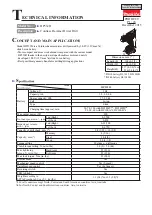
15
OPERATION
Fig. 11
WRONG
REMOVING BITS
See Figure 10.
Lock the switch trigger by placing the direction of
rotation selector in the center position.
Open the chuck jaws.
NOTE:
Rotate the chuck body in the direction of the arrow
marked
UNLOCK
to open the chuck jaws. Do not use a
wrench to tighten or loosen the chuck jaws.
Remove the drill bit.
DRILLING
Check the direction of rotation selector for the correct
setting (forward or reverse).�
Secure the material to be drilled in a vise or with clamps
to keep it from turning as the drill bit rotates.�
Hold the drill firmly and place the bit at the point to be
drilled.�
Depress the switch trigger to start the drill.
Move the drill bit into the workpiece, applying only enough
pressure to keep the bit cutting. Do not force the drill or
apply side pressure to elongate a hole. Let the tool do
the work.
WARNING:
Be prepared for binding at bit breakthrough. When
these situations occur, drill has a tendency to grab
and kick opposite to the direction of rotation and
could cause loss of control when breaking through
material. If not prepared, this loss of control can
result in possible serious injury.
When drilling hard, smooth surfaces, use a center punch
to mark the desired hole location. This will prevent the
drill bit from slipping off-center as the hole is started.
When drilling metals, use a light oil on the drill bit to keep
it from overheating. The oil will prolong the life of the bit
and increase the drilling action.
If the bit jams in the workpiece or if the drill stalls, stop
the tool immediately. Remove the bit from the workpiece
and determine the reason for jamming.
NOTE:
This drill has an electric brake. When the switch
trigger is released, the chuck stops turning. When the
brake is functioning properly, sparks will be visible through
the vent slots on the housing. This is normal and is the
action of the brake.
Fig. 12
Содержание R820011
Страница 18: ...18 NOTES...






































